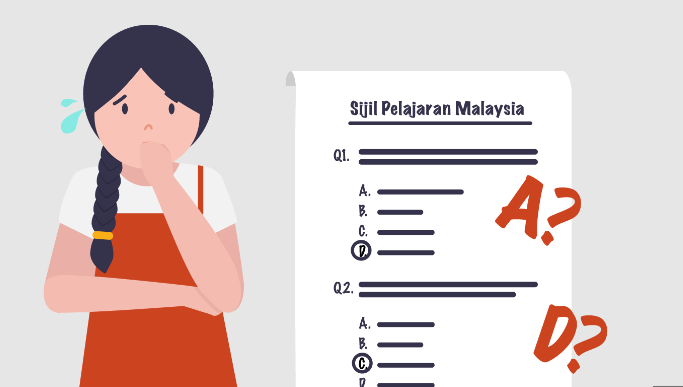Study strategically for the SPM by utilizing past papers, maintaining a balanced diet, and simulating exam conditions to improve time management.
Table of Contents
Understand the Exam Format and Syllabus
In order to navigate the SPM, one first needs to understand the format and syllabus. There are multiple subjects within the Sijil Pelajaran Malaysia, each of them has a somewhat different format, and an even more profound difference in terms of its syllabus. By familiarizing with those, students can tailor their approach accordingly and vastly improve their chances of a high score. To start, one must access the official syllabus from the Ministry of Education’s website or by asking the teacher. For instance, a standard Mathematics paper divides into sections of algebra, geometry, and statistics. According to the syllabus, algebra is worth around 30% of the final grade.
To be as practical about it, one must also compare the content of the current syllabus with that of previous years. For example, if previously, trigonometry was 15% of the exam, and now it is 20%. A typical approach would be to also spend 20% more time on trigonometry studies. It is important to divide time based on each exam section’s weight. For instance, if it is 30% of the final result, and one studies an average of 10 hours per week, then, perhaps, an assignment of 3 hours per week is reasonable. Focusing one’s energy in such a manner means they will not spend too much effort on something that comprises too little of the final grade.
One must also understand the exam format. For the most part, each subject will have MCQs, or multiple-choice questions, structured questions, or essay-type questions. A standard practice is to understand that MCQs often do not go into the detail that essay questions do, so those must be covered accordingly. It will also be useful to inquire with the teacher, especially there is any format uncertainty. Even if the students know the format, the wisdom of the teachers can help the students understand which section of the syllabus is often emphasized in these exams.

Develop a Study Schedule
An effective study schedule is a foundation for every Malaysian student trying to pass the SPM. It is the best way to make sure that all the necessary material is covered without rushing or, even worse, cramming. The secret to designing an effective study plan is to know your own pace and the time needed to understand each of the subjects.
First of all, list all the subjects and chapters or topics in each. Look at them with a fresh mind to decide how difficult each will be for you and how long it will take to understand it. For example, maybe you want to spend 15 hours mastering Physics as you always find it challenging and only 10 hours on History, as you usually find it easier.
Secondly, think of the time until the exam. If there are 12 weeks until the SPM and you can spend 20 hours per week studying, there will be 240 hours in total. You should plan how to use these hours equally on subjects. The subjects you need to spend more time on are those that can decide your final grade, so maybe you will want to spend 40 hours on Mathematics and Science and two hours on Elective.
Make sure to divide your schedule into daily or, at least, weekly tasks to make it more manageable. Alternatively, set a goal for yourself to master three new topics in Mathematics every week.
Including reviews, maybe weekly, will also help you understand and remember the material. Maybe you can spend this Saturday block of two hours to review all the topics you have learned throughout the week and give yourself some more time to think of those difficult.
Try out various study audiobooks apps that also allow you to track the time you spend studying and remind you to take short breaks every 50 minutes. It is always easier to stick to a study schedule when there is a digital tool that will send you notifications about times and your own progress.
Make sure to have enough breaks between study sessions and free days after intensive weeks. Maybe divide your study session into 50 minutes of intense work and a 10-minute break. Avoid physical exhaustion to feel vigorous throughout the exam season.
Use Past Year Papers
One of the most effective ways to excel in the SPM is to utilize past year papers. It is a well-known fact that these papers help students to gain insights into the exam format, the types of questions asked, and the marking system, allowing them to make the most of preparation . In other words, past papers help students to relate passive study at home to active application required in the exam hall. Similarly, no study will be successful if the student ignores past year papers. Collection of as many past year papers as possible is the first step in the effective utilization of this tool. For most subjects, schools provide past year papers, and students can always search the internet for additional resources, which are mostly available for free download or purchase . I would advise a student to collect as many papers as possible as the different years invariably vary the types of questions.
The next step would naturally be to integrate the papers into the study program. A simple rule could be that a student starts to work on the past papers at least six months prior to the exams. At first, students may attempt one set of paper per week per subject. As the exams draw nearer, a weekly program may be intensified to daily practice of past year papers. This will ensure enough time to analyze and understand mistakes. A student may find answers to the papers with the help of a friend or a teacher . He or she can also join a study group that will divide the paper into sections, each member solves these sections and discusses their answers with others. The most important rule is to always time oneself to complete a paper. Initially, it may be permissible for one to take more time than the allocated time in an exam hall. However, by the last month to exams, one should be able to complete any paper within the stipulated time. I can confirm that I have put this method personally into practice and also encourage others to do the same. The outcome is evident in enhanced time management skills, lack of any surprises in and effective problem-solving techniques. Moreover, with systematic use, a first student will gain more confidence and will be less prone to panic.

Group Study Sessions
For Malaysian students headed for the SPM, group study sessions are an excellent way to facilitate learning. The idea is to combine the knowledge and perspectives of other students and the students themselves. This allows students to discuss and resolve issues together, learning from each other along the way. . To instigate an effective group study session, students must identify their fellow students, the ones they will feel comfortable with.
Students should be serious about their studies and work toward a mutual goal. Additionally, groups formed should balance their members’ strengths and weaknesses. One student can be better going for Chemistry, another student, better for Mathematics, and then they can support each other through their weak areas. To facilitate the learning process, students should set objectives for each meeting and thinking about what they will study before meeting. Sometimes it helps if one student covers part of the syllabus and passes the knowledge to the group. This way, students not only learn from others, but they also clarify their understanding as they teach others.
During study hours, students should focus on solving exercises. However, this strategy is often flawed as students spend time not understanding problems but instead memorizing their formulas. Other fruitful practices include discussing crucial concepts, asking each other, or perhaps testing each other through random questions or quizzes . The meeting place and time also depends as it hugely determines the success of the group study. Effective study groups should dedicate two hours each week for a quiet room in the library. This allows students to plan their other schedules around their study group. In addition, defining an appropriate duration and place helps getting into a routine, as meeting in random places will make students complacent. Finally, it can be apparent that the formation and performance of student groups alongside technology usage can be an excellent resource for learning. A physical study group can, for example, break down daunting information into bite-sized bits. This way, simple distillation topics become very easy. For instance, during the SPM revision, organic chemistry can be tough. However, with a friend who is proficient in the area, he or she can simplify your understanding by using simple analogies or creating basic diagrams. Technology can also be integrated within the group. Tools, such as Google Docs and educational apps, can allow group interaction outside the physical library.
ocus on Weak Areas
For Malaysian students, focusing on weak areas is essential for the success of the SPM. Doing so can lead to a substantial increase in the overall performance because every subject’s mastery is essential for obtaining the best scores. Addressing weaknesses in a strategic way can be divided into a few steps, which will ensure efficient learning.
First, it is important to review one’s previous tests and assignments thoroughly to see if there are areas and topics where a student is consistently deficient. For example, a student that frequently makes mistakes with algebra or finds it challenging to comprehend English texts will have these areas highlighted. Then, it is necessary to set clear, concise, and achievable goals to improve in these areas.
One practical way to do so is to allocate more time for weaker subjects’ studying. For example, if the overall time of study for a student is 10 hours a week and he spends 2 hours weekly on a weaker subject, he should increase this time to 4 hours. It is important to devote this time not only to reading or reviewing the material but also to actively solving problems and trying to write essays if applicable .
Also, one should use any additional resources available, as it can be critical to understand a subject fully. For example, for mathematics, there are many interactive platforms available, such as the Khan Academy or the local PT3 SPM page, where one can brush up on tutorials and solve thousands of problems. For languages, reading books or internet articles and trying to write essays on different topics can play a crucial role in improving the understanding and writing skills.
Peer tutoring is also an effective way to do so. Many times, students that excel at some subjects can explain their understanding of the topic from the student’s rather than teacher’s perspective. For example, biology student A can explain photosynthesis using easier analogies or a diagram. It is also important to assess the knowledge on problem topics biweekly to see if there is any of a student’s misunderstanding present and whether it is time to work on some new areas of the subject. Regular feedback from teachers can also guide a student on how to study better and more effectively.

Stay Healthy
Health is crucial for the Malaysian students, who are in the midst of preparation for their SPM, because proper physical and general feelings of well-being contribute to effective studying and cognitive function. Optimal concentration, for example, can be achieved through the implementation of a proper lifestyle that includes well-balanced nutrition, exercise, and regular rest. The choice of food can help with supporting brain health since nutrition affects the energy levels and the ability to retain information for prolonged periods. Consuming enough vitamins and minerals, finding omega-3 fatty acids in fish, for instance, or eating fruit known to increase individual memory and food processing speed. Regarding a general diet, the menu should include a wide range of foods including fruit, vegetables, meat and fish, as well as dairy and wholemeal products. Drinking water is also important because dehydration can damage individual brain function. Another beneficial aspect of students’ proper lifestyle is exercise. The physical movement creates an increased blood flow to the brain and assists in the process of retaining information from study sessions. 30 minutes of an exercise per day is recommended with such activities as brisk walking, cycling, or swimming.
Sleeping is also vital for overall health and is an effective general strategy employed to improve memory and retaining skills. The vast majority of students try to study for longer periods of time and neglect the time for sleep while it is a completely wrong approach. 7-9 hours of sleep per night is essential for the optimal functioning of the brain. In order to enhance the quality, as well as the quantity of sleep, I would recommend going to bed and getting up at the same time every day since it assists the body in regulating the internal clock. If we decide to implement stress management, then meditation and yoga practices, for instance, can be helpful. Stress is an inevitable part of preparation but it is the anxiousness that hinders the proper use of study time. Mindfulness meditation is useful for both adults and students and it can serve as an alternative in situations of panic and sleeplessness.
Prepare Mentally for the Exam Day
Mental preparation for the exam SPM is just as important as the actual exam preparation. It is important as it not only helps reinforce the knowledge and skills but also optimizes the mindset and helps to reduce the number of things leading to anxiety. Mental preparation can help significantly boost students’ confidence and preparedness when they have to take the exam.
The first strategy on mental preparation is visualization. It means that the students are to create a mental image of their success and revise it repeatedly. It can be anything from the image of entering the examination hall and successfully answering the questions to receiving the actual result with the grade the person would like to get. In order for it to work, the visualization exercise should be repeated daily for several weeks before the actual exam, and positive reinforcement doesn’t make the students as nervous and worn out, preparing them earlier.
Another strategy that can be applied is the exam simulation. The students should instrumentalize themselves and try doing a paper in the same setting they are planning to do the actual exam. For example, if they are planning to study at home, they should do calculations and papers at home, whereas if they are planning to study in a library, they can choose to study there. The purpose of the exercise is to test how fast the students are and whether the activities conservatively take the predefined time. It also helps you to remember the feeling of working or “competing”, which many people find extremely beneficial.
Daily positive affirmations are also quite a good method, as getting the mindset trained can help to shift the focus from “don’t fail” to things that are actually beneficial for the students to do. Therefore, he or she can make an exercise to repeat to themselves how they are prepared for the exam daily, or how they can answer all of the question successfully. Taking regular intervals or breaks between the studies is crucial for success, too, as breaks can be a complete change in the mode.
Talking to peers, friends, teachers, as well as family members can also help to lessen the burden of preparation and exams. It helps to keep in touch with friends and share ideas and stresses, as well as promotes possible support for exam preparations. Finally, estimation is the key to success as well – setting the mark you should achieve will make you feel less stressed and capable of studying effectively.

